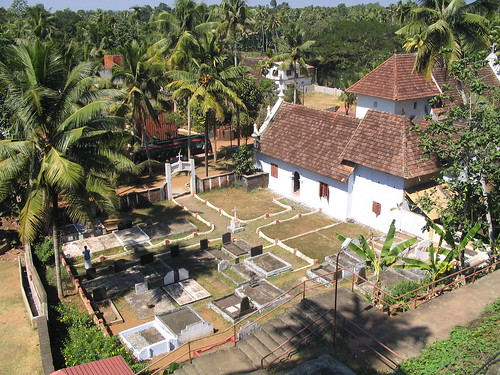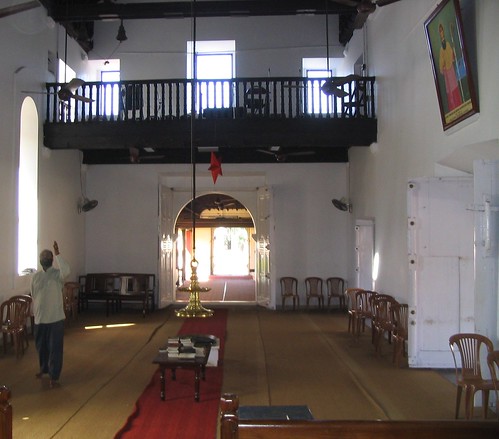Old Churches In Kottayam: we used to be Nestorian ?
First a brief history. The christian community in Kerala has been around for a long time (ever since St.Thomas visited in AD.52 they say). Supposedly, the community was small and struggling until the fourth century when Thomas Knai, a christian from Persia, arrived with his large family and many others. Mr.Knai, by the way, was fleeing persecution from the Zorastrian Sassanid rulers of Persia. Because of active trade in the Arabian sea the church in Kerala kept in moderate contact with the church in Persia (sometimes known as the Nestorians) for the next several centuries. Finally the Portuguese imperialists arrived. On encountering the christians in Kerala they decided that they were heretics who needed to be brought under the authority of the pope in Rome. They were fairly successful in convincing people of this (and catholics are the largest group of christians in Kerala today), but many resisted.
So in 16?? a group of christians took an oath (known as the oath of the Coonan Cross) to resist the Papal advances. They wrote to several orthodox churches (I presume the churches of Alexandria, Antioch, Constantinople etc) for help. By this time their old brothers the Persian church had become weak and 'retreated to the mountains', and the first to reply to their appeals for help were the Syrian Orthodox (also known as the East Syrian Church and disparagingly as Jacobites or Monophysites). [Disclaimer: all these labels come with a lot of theological baggage, and I am in no position to decide their accuracy. I use these terms out of convenience. A lot of my knowledge comes from Samuel Moffett's book A History of Christianity In Asia, which portrays both Nestorians and Jacobites quite sympathetically.] The remaining orthodox christians in Kerala thus came under the hierarchy of the Antiochian patriach. There were a few more theological and political bifurcations of the church (and more european imperial meddling) in the centuries to follow.
Cheriyapally was built around 1575 --- after the Portuguese landed and before the Coonan Cross Oath happened. The general architecture is european --- the facade reminds me of the churches of Goa. So are the murals on the sides of the altar. Some of the more recent murals on the far side of the altar have distinctly Catholic themes (such as the crowning of Mary by the Father,Son and Holy Spirit). Then there is the influence of local Hindu temple architecture --- for example in the wood carvings inside the church, and the oil lamps in the outer wall of the church.
The set of all my photos is here. On my list of places to visit on future trips : the 1000-yr old Thazhathangadi mosque (incidentally Islam also first arrived in India in Kerala via the arabian-sea trade), the St.Thomas Mount church (and Nestorian cross) in Madras, and Kodungallur (or wherever there are older relics of Kerala's christian past).




10 Comments:
Do try to blog more often....it's a delightful blog.
Thanks Sunil :) I'll try...
My roots are in Kottayam too and I camp at Thazhthangadi at my Aunt's place during my visits there. So I know of all the places you wrote about, except for the history of course. Wonderful post!
Thanks a lot for the kind words, Manoj. I'm glad you liked the post.
Wow, what a great bit of archaeological research you did. Through your post, I learned about this interesting cross-pollination of disparate cultures (bringing cultures closer together is something I live for -- they got around!)
Incidentally, my family was based out of Mylapore before the American and Australian exodus. In 1995, I visited the St. Thomas basilica, one of the major tourist attractions by our house. For all the weirdness Catholicism has wreaked on this planet, their architecture is simply breathtaking. Every time I walk into a Catholic church, I feel some spirit regardless of my being a Hindu. It's very inspiring, as is St. Thomas basilica. Supposedly, a finger of St. Thomas is the relic on display here, while his body is interred in St. Thomas Mount, several 10s of miles away.
(Question: Would this church be considered Catholic sensu stricto? I am just beginning to learn in detail about the origins of Christianity in the east.)
Thankfully, the basilica didn't suffer much during the recent tsunami.
Thanks Maitri. I too find unexpected cultural cross-pollination really fascinating (and Kerala is especially full of it)
Despite having been in madras hundreds of times I've never actually been to the St.Thomas Basilica.
Christian churches are usually classified as being either Roman Catholic, Protestant or Easter Orthodox(eg. Greek, Coptic, Ethiopian, Armenian, Syriac etc). And the church buildings described above are under the jurisdiction of churches that would be classified as Orthodox, so they would not be considered Roman Catholic. In kerala the group of formerly Orthodox christians that came under the jurisdiction of the Pope after the arrival of the portuguese are known as 'Eastern-Rite Catholics' or Syrian-catholics. The catholic architectural influence in the church buildings above is because they were built at a time that the Portuguese were dominant, and before a few kerala christians formally broke off from the Portuguese (at the oath of the Coonan Cross) and retook control of a few churches.
The history of world christianity goes something like this. In the first couple of centuries there were a bunch of different patriachs all over middle-east, europe and north-africa --- Rome, Constantinople, Armenia, Antioch, Alexandria etc. They used to meet periodically at "Councils" to decide exactly what they believed (and who they considered heretics). The first schism occured around the fifth century when a few patriarchs decided not to attend the council of Chalcedon. These non-chalcedonian churches include the churches of Alexandria (Coptic), Ethiopia, Armenia, Syria (Monophysite), Persia (Nestorian). The orthodox churches of kerala are also non-chalcedonian. The second bifurcation occured in the 10th or 11th century when the Roman Catholics broke off from the other remaining chalcedonian orthodox churches (eg. Greeks, Russians, Slavics etc). The third major bifucation was the Reformation that happened in Europe a few centuries later, and gave birth to Protestantism (and numerous resulting denominations). Probably more than you wanted to know :)
Thanks so much for the lesson. You can tell me all you want -- I am all ears, or all eyes in this case. There is so much that has happened in the world that modern (western) history textbooks conveniently gloss over or omit altogether. Thanks again!
Hi! Came here via Sepia Mutiny.
While I have read about the Reformation, and a little about Syrian Christians, I have always been curious about the Christians of the Arab world. (I came to know that Khalil Gibran was a Lebanese Christian.)
An interesting blog. I have also noticed your thought-provoking comments on other blogs (thanks to your name's unique spelling.) :)
Thanks Srikanth.
About the spelling of my name: I know most Indian languages don't differentiate between V and W, but I think the pronunciation of my name is closer to a V than a W.
I saw this post while i was doing some research on Ethiopian Influence in Christianity in Kerala.
Thanks for a good write up on church history .
My interest primarilly stemmed from the fact one of the college hostels of M.A College of Engg where i studied was funded by Heily Selasse(Donno whether i spelt it correct) ethiopian king and spiritual leader . Accidentally i went to an Ethiopian restaurant in Santa Clara and i just realized many of the traditional christian kerala non veg has vey close ethiopian counter parts .
Post a Comment
<< Home